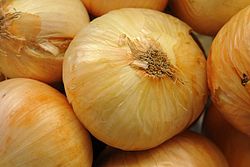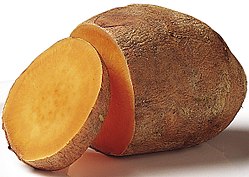| Name | Image | Description |
|---|
| Apples |  | Apples were introduced into North America by European colonists. Enslaved people made use of apples; they were battered and deep fried in oil. Apples and other fruits were dried and saved for later until consumption. [51] |
| Bell peppers |  | Bell peppers were grown in the gardens of enslaved people and were added to dishes to add flavor to food. [52] |
| Black-eyed peas |  | Black-eyed peas are native to Africa. [53] Often mixed into Hoppin' John or as a side dish. [1] Pictured are black-eyed peas with smoked hocks and corn bread. |
| Cantaloupe |  | A variety of cantaloupe in Africa came to North America by way of the slave trade. African Americans grew cantaloupes in their gardens. [54] |
| Cayenne pepper |  | Cayenne peppers are native to the Americas. Enslaved and free people used cayenne peppers to make a homemade barbecue sauce and was used to add heat and flavor to other dishes. [55] |
| Collard greens |  | A staple vegetable of Southern U.S. cuisine, they are often prepared with other similar green leaf vegetables, such as kale, turnip greens, spinach, and mustard greens in "mixed greens". [56] They are generally eaten year-round in the South, often with a pickled pepper vinegar sauce. Typical seasonings when cooking collards can consist of smoked and salted meats (ham hocks, smoked turkey drumsticks, pork neckbones, fatback or other fatty meat), diced onions and seasonings. Historians at Cornell University noted the importance of collard greens in African-American cuisine: "Collards were among several leafy green vegetables enslaved people grew in their own gardens, enabling them to carry on a West African tradition of incorporating leafy greens into soups and stews." [57] |
| Corn |  | During slavery, corn was part of enslaved African Americans diet. Slaveholders provided cornmeal to their slaves to make meals. It was used by enslaved people to make corn bread, hominy, and boiled corn. [58] African Americans learned from Indigenous people/Native Americans how to make ash cake, "hoe cakes", and porridge from corn. [59] During slavery and after emancipation, African Americans used cornmeal to dredge their meats and fish and was used to bake their food. [60] |
| Cornmeal |  | "Cornmeal was the most prevalent foods available to slaves." A former slave named Callie Elder from Georgia said her grandfather cooked catfish with lard, salt, and pepper, and rolled the catfish in cornmeal before baking. The enslaved covered their meats with cornmeal before they were fried or baked. [61] Frederick Douglass mentioned in his autobiography the rations of food enslaved men and women received in Maryland's Eastern shore: "The men and women slaves received, as their monthly allowance of food, eight pounds of pork, or its equivalent in fish, and one bushel of corn meal". [62] |
| Cucumber |  | Enslaved people grew cucumbers in their gardens to supplement their diets. [46] Cucumbers are used in soul food to make a cucumber relish. [63] |
| Eggplant |  | A species of eggplant was cultivated in Africa and brought to North America by way of the slave trade. President Thomas Jefferson grew them in his garden at Monticello. [64] In soul food they are sliced, seasoned and placed in flour and hot oil for cooking; they are also an ingredient when making fritters. [65] |
| Fish peppers |  | Enslaved and free African Americans in the Chesapeake Bay area and in Baltimore, Maryland grew fish peppers in their gardens to add flavor and heat to their seafood dishes. Food historian Michael Twitty suggests fish peppers were brought to the United States from Haiti. [66] [67] [68] |
| Garlic |  | Garlic was grown in enslaved people's gardens to add flavor to soups, stews, and meats. [69] [52] |
| Gherkin |  | Gherkin is a species of cucumber native to Africa that was brought to North America by way of the slave trade. [70] Enslaved African Americans grew them in their gardens on the plantation of President Thomas Jefferson at Monticello in Virginia. [46] They are used in soul food cuisine to make a pickled relish. [71] |
| Guinea pepper |  | In 1748, Peter Kalm, a Swedish-Finnish botanist, noted enslaved Africans in Philadelphia cultivated guinea peppers, a hot pepper native to West Africa. The pods of the pepper were pounded and "mixed with salt preserved in a bottle" to make sauces poured over fish and meats. [72] |
| Herbs |  | During slavery and after emancipation, African Americans grew herbs in their gardens to add flavor to food and for herbal medicine also called folk healing. [73] The herbs and flowers grown were basil, calendula, rosemary, thyme, parsley, sage, oregano, borage, lemon balm, hops, chamomile, and other herbs. [52] Slaves seasoned beans with one table spoon of mixed herbs, minced garlic, salt, pepper, fried bacon, onion, and hot sauce. [69] |
| Hoppin' John [74] |  | A dish that originated in Gullah communities in the Low country region of South Carolina, but is now popular in many areas of the south, [75] consisting of black-eyed peas (or field peas) and rice, with chopped onion and sliced bacon, seasoned with a bit of salt. [76] Some people substitute ham hock, fatback, or country sausage for the conventional bacon; a few use green peppers or vinegar and spices. |
| Irish potato |  | Enslaved people in Virginia grew Irish potatoes in their gardens to make one-pot stews. [77] In the records of slave narratives, a former slave named Millie Evans from Arkansas made an Irish potato pie. [78] |
| Kola nut |  | The kola nut was brought from West Africa to North America by way of the slave trade. [79] Africans used it in their Orisha religious practices. Kola nuts were used to make Coca-Cola a carbonated soft drink. [80] |
| Lima beans |  | Lima beans are native to Central America. [81] Portuguese explorers introduced lima beans into the African continent. [82] Enslaved people in Virginia grew lima beans in their gardens to make one-pot stews. [83] Today lima beans are enjoyed eaten as a dish in one-pot stews. To flavor them, bacon and chicken broth is added in a pot when cooking. [84] |
| Mustard greens |  | A species of mustard plant. Subvarieties include southern giant curled mustard, which resembles a headless cabbage such as kale, but with a distinct horseradish-mustard flavor. It is also known as green mustard cabbage. |
| Okra [85] |  | A vegetable that is native to West Africa and is eaten fried or stewed and is a traditional ingredient of gumbo. It is sometimes cooked with tomatoes, corn, onions and hot peppers. In West Africa and in African-American cuisine, okra is used to thicken stews and soups. [86] In Gullah communities, cooked okra soup is prepared with "...tomatoes, and smoked meat served over rice." [87] |
| Fried okra |  | Okra pods that have been sliced and dredged in cornmeal before frying. |
| Onion |  | Onions were grown in the gardens of enslaved people to add flavor to soup, stews, and meats. Onions were added with garlic and peppers in a skillet to add additional flavor to food. [69] [88] |
| Peach |  | Peaches were introduced into North America by European colonists. African American slaves stewed peaches and made peach pies and brandy. Peaches and other fruits were dried and saved for later until consumption. [89] |
| Peanuts |  | West Africans mixed the Bambara groundnut with yams, cereal, flour, African palm oil, and melegueta pepper. Portuguese explorers introduced the American peanut from Brazil into the African continent. Africans grew peanuts in their gardens and made soups and stews with this food. Peanuts were also used as food on slave ships to feed enslaved captives. Enslaved Africans in the Southern United States prepared meals using peanuts similar to how they used the African Bambara groundnut. Slaveholders considered the peanut "slave food," and was the reason white plantation owners did not eat peanut dishes prepared by their slaves. [90] Peanuts were grown in the gardens of enslaved people and were made into soups, stews, and peanut butter. [52] [91] |
| Persimmons |  | Enslaved African Americans made recipes with persimmons. Persimmons grew wild in the South and were available during autumn (fall) season, and slaves harvested them by shaking persimmon trees or gathering them off the ground. Some slaves grew persimmons. They were made into pies, drinks (beer), combined with cornmeal, and added to other foods to make a meal. [92] |
| Sea Island red peas |  | Sea Island red peas are a variety of cowpea from West Africa brought to the sea islands of South Carolina during the slave trade. They are used in Gullah rice and bean dishes. [93] |
| Sesame seeds |  | Sesame seeds are native to West Africa and were brought to South Carolina in 1730 by way of the slave trade. Enslaved and free Black people used sesame seeds to make sesame pudding, prepared stews, baked breads, and boiled their greens with sesame seeds. Slaves ate sesame raw, toasted, and boiled. It was used as an ingredient for baked breads in colonial America and is still used in the present day. [94] |
| Squash |  | Squash is native to Central America and are also called sweet potato pumpkin. It was grown in the gardens of enslaved Black Americans in Virginia. President Thomas Jefferson recorded in his journal the vegetables his slaves grew. Jefferson noted: "On account of the extreme resemblance of its taste to that of the sweet potato, it may be originating form your islands…it is well esteemed at our tables, and particularly valued by our Negroes." As enslaved people moved to the Appalachian Mountains they brought the seeds of squash with them and influenced Appalachian cuisine. [95] |
| Sweet potatoes |  | Often parboiled, sliced, then adorned with butter, sugar, cinnamon, nutmeg, vanilla or other spices, and baked; commonly called "candied sweets" or "candied yams" [27] |
| Tomato |  | Tomatoes are native to the Americas. Free and enslaved African Americans grew tomatoes in their gardens to make one-pot stews and gumbo. [96] Former slave Clara Davis from Alabama cooked catfish using tomatoes and potatoes or prepared baked catfish with a tomato gravy and sweet potatoes. [97] |
| Turnip greens |  | Turnip leaves are sometimes eaten as "turnip greens", and they resemble mustard greens in flavor. Turnip greens are a common side dish in southeastern US cooking, primarily during late fall and winter. Smaller leaves are preferred; however, any bitter taste of larger leaves can be reduced by pouring off the water from initial boiling and replacing it with fresh water. Varieties specifically grown for the leaves resemble mustard greens more than those grown for the roots, with small or no storage roots. |
| Watermelon |  | Watermelon came from Africa to North America by way of the slave trade. Enslaved African Americans grew them in their gardens for food. Due to their red color, they are eaten during Juneteenth celebrations. The color red represents resilience and joy. [98] [99] |









































































